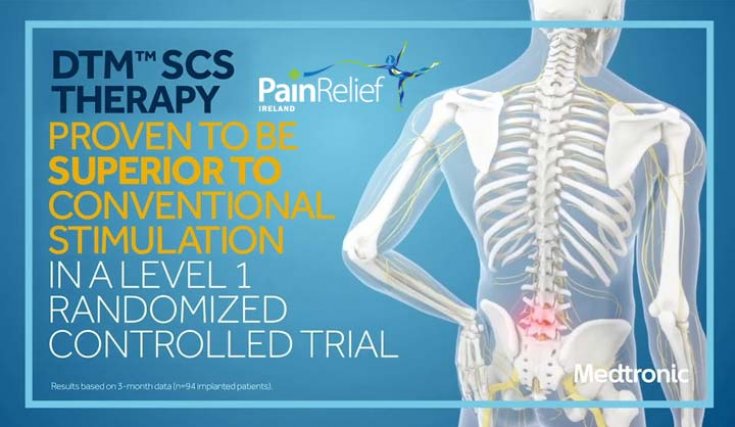
Pain Relied Ireland is pleased to announce that it has implanted the first Differential Target Multiplexed (DTM™) Spinal Cord Stimulation (SCS) for back pain on Medtronic devices using the Intellis platform. This is a new and unique programming option available to treat patients with chronic pain that is based on years of preclinical research. We can now offer suitable individuals the benefit of this advanced programming.
Dr. Dominic Hegarty (Consultant in Pain Management & Neuromodulation) who implanted the first two cases in Ireland at the Mater Private Hospital, Cork, says that “this new waveform may engage a novel mechanism that modulates both neurons and glial cells, expanding the understanding of SCS mechanisms of action”. The glial cells out number neurons in the spinal cord by 12:1 and their role in pain have been explored in research for more than 20 years. This is an exciting advancement in this area and Dr. Hegarty is delighted to have been given the opportunity to offer it to his patients first. The neuromodulation service is the Mater Private in Cork has grown steadily over the last 18 months and now implants a greater number of devices targeting a variety of complex cases resulting in an enormous improvement in the daily life of many chronic pain patients.
What is DTM Spinal Cord Stimulation?
DTM therapy, which was proven through the RCT only on the Medtronic Intellis™ platform, is a new and unique programming option available to treat patients with chronic pain that is based on years of preclinical research.
This research has shown at three-month results from a large, multicenter randomized controlled trial (RCT) showing statistically significant (p=0.0009) and superior back pain relief with Differential Target Multiplexed (DTM™) Spinal Cord Stimulation (SCS) compared to conventional SCS. Both arms used the Medtronic Intellis™ platform.
The RCT demonstrated profound pain relief and significant reductions in back and leg pain with DTM.
- Sixty-three percent patients with back pain treated with DTM reported profound pain relief of 80% or greater compared to 26% treated with conventional SCS.
- In aggregate, patients treated with DTM reported an average of 74% reduction in back pain compared to 46% with conventional SCS at three months.
- Similarly, improvements were observed with DTM for leg pain with a mean reduction of 72% compared to 59% with conventional SCS.
The RCT results reported are from 94 implanted SCS patients who were randomized to either the treatment or control arm and followed over the course of three months. With these results the study met its primary endpoint of noninferiority compared with conventional SCS, and a pre-specified secondary statistical test for superiority showing the difference between DTM and conventional SCS as highly significant. The study will continue to follow patients through 12 months post implant.
Science of DTM
DTM has been studied in animal models, showing statistically significant reversal of pain behaviours compared to either low frequency or high frequency alone. In addition, preclinical studies investigating the genome of nerve-injured animals suggests that the DTM waveform has a greater impact in the neural-glial interaction than other frequencies. Basic science research is further expanding our understanding of SCS mechanisms of action. Glial cells are no longer thought to be only “glue” in the brain and spinal cord but active contributors to neural processing and various disease states including chronic pain. The fact is that glial cells have be proposed to have a role in pain for many years but it has been difficult to understand how they have an impact. This data has shown how it could be possible to have a significant impact on chronic pain.
Do you think you may benefit from the DTM therapy?
Spinal cord stimulation and the use of technology to offer personalised pain management will continue to grow as a therapy. Correct identification of suitable individuals is critical. If you have persistent lower back or lower back and leg pain then may be for you.











